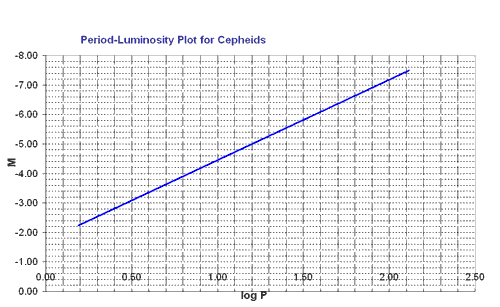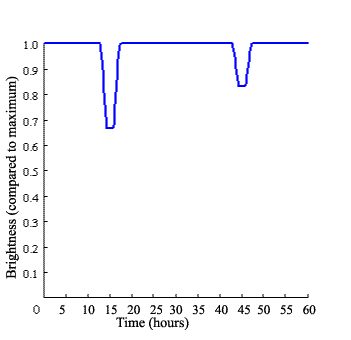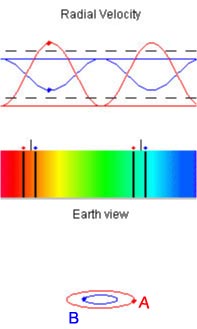Binary & Variable Star Questions
Here are a few questions to get you started. Additional questions will be added over the next few days so check back soon. Click on the blue answer tags to get answers (and worked solutions for some questions).
Note; you may use the plot of the period-luminosity relationship for Type I Cepheids below to help you answer some questions.

- An astronomer observes an object, producing the following relative light curve.
 Light curve for question 1.
Light curve for question 1.a) What type of object is this?
b) Account for the shape of the observed light curve.
c) What does the information on the time axes suggest about the physical properties of the object?
a) This light curve is typical of an eclipsing binary system.
b) An eclipsing binary is where two stars alternately eclipse each other. Their orbital plane is side-on or almost side-on to Earth. When the two stars are side-by-side to an observer on Earth, the total luminosity of the observed system equals the combined output of the stars. When one star passes behind the other, the overall luminosity of the system appears to drop, causing a dip or minima on the light curve. A second minima occurs when the other star is eclipsed. If the two minima differ in depth and shape it indicates that the stars have different sizes, densities, effective temperatures and even shape. In general the deeper or primary eclipse occurs when the hotter of the two stars passes behind the cooler star. A shallower, secondary eclipse occurs when the cooler star is eclipsed by the hotter one.
c) The period for this eclipsing binary system is about 60 hours. This is relatively short compared with the orbital period of many visual binaries (tens to hundreds of years) so the two component stars must be very close together (<1 AU) and orbiting each other at very high velocities. - Two stars, A and B form a spectroscopic binary as shown in the diagrams below.
 Radial velocity plot, spectrum and Earth-view of spectroscopic binary system.
Radial velocity plot, spectrum and Earth-view of spectroscopic binary system.a) Which star is more massive?
b) Explain why the spectral lines periodically split then move together in a system such as this.
c) Why do the stars have different ranges in their radial velocities?
a) B is the more massive star.
b) The periodic shifting (splitting and coming together of spectral lines) arises to the Doppler shift of each star's spectrum as it orbits the barycenter. When the star is moving towards us, its spectrum gets blue shifted so that its spectral lines appear to shift towards the blue, shorter wavelength part of the spectrum. At the same time the other star will be moving away from us relatively so its lines will appear redshifted to longer wavelength. When the stars are moving across our line-of-sight no relative Doppler shift occurs so we simply see the two sets of lines superimposed in the one spectrum. As the stars move further around in their orbits the first star now appears redshifted and the other one blue-shifted.
c) Star A is less massive than star B. This means that its orbit is wider hence it has further to travel in a given orbital period. It's radial velocity must therefore be greater than B's. - An astronomer observes a Cepheid in each of the galaxies X and Y. Both Cepheids have the same mean apparent magnitude but the Cepheid in galaxy X has a longer period than that in galaxy Y. Which galaxy is more distant? Justify your answer.
The Cepheid in galaxy X is intrinsically more luminous than that in Y because it has a longer period. The period-luminosity relationship shows that the luminosity increases with period for Cepheids. As both Cepheids appear equally bright in the sky the more luminous one, in galaxy X, must therefore be further away as light obeys an inverse-square relationship. If the Cepheid is further away, the galaxy in which it is found, X, must also be further away than that in Y. - Why is a Type I Cepheid more useful for determining extragalactic distances than RR Lyrae stars?
Type I Cepheids are intrinsically more luminous than RR Lyrae stars. They can, therefore be detected at greater distances than the RR Lyraes so can be used to find the distance to more remote galaxies.
